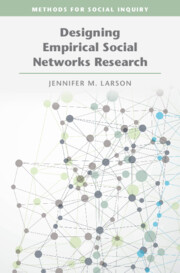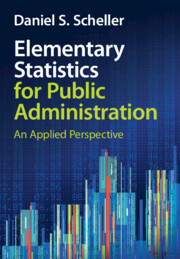Refine search
Actions for selected content:
134 results

Empirical Research and Writing
- A Political Science Student's Practical Guide
- Coming soon
-
- Expected online publication date:
- January 2026
- Print publication:
- 22 January 2026
-
- Textbook
- Export citation
1 - Theoretical Framework and Research Design
- from Part I - Foundations
-
- Book:
- Crises, War, and Diplomacy
- Published online:
- 07 November 2025
- Print publication:
- 20 November 2025, pp 7-22
-
- Chapter
- Export citation
1 - Introduction
-
- Book:
- Judging under Constraint
- Published online:
- 27 October 2025
- Print publication:
- 13 November 2025, pp 1-21
-
- Chapter
- Export citation
The Data Frontier: Expanding Empirical Horizons in Chinese Management Research
-
- Journal:
- Management and Organization Review , First View
- Published online by Cambridge University Press:
- 07 November 2025, pp. 1-7
-
- Article
-
- You have access
- Open access
- HTML
- Export citation
Hypothesis testing miscommunication in psychiatric randomized controlled trials
-
- Journal:
- The British Journal of Psychiatry , FirstView
- Published online by Cambridge University Press:
- 17 September 2025, pp. 1-2
-
- Article
-
- You have access
- HTML
- Export citation
Incorporating the gender dimension into infectious disease research: how is Parasitology progressing?
-
- Journal:
- Parasitology , First View
- Published online by Cambridge University Press:
- 13 August 2025, pp. 1-7
-
- Article
-
- You have access
- Open access
- HTML
- Export citation
4 - Data Handling
-
- Book:
- Analysing Sociolinguistic Variation
- Published online:
- 19 June 2025
- Print publication:
- 03 July 2025, pp 47-64
-
- Chapter
- Export citation
4 - The Shifting Focus of CALL Research
- from Part I - Laying the Foundations
-
-
- Book:
- The Cambridge Handbook of Technology in Language Teaching and Learning
- Published online:
- 15 June 2025
- Print publication:
- 26 June 2025, pp 58-72
-
- Chapter
- Export citation
2 - Bounded Accountability
-
- Book:
- Incumbency Bias
- Published online:
- 17 May 2025
- Print publication:
- 05 June 2025, pp 24-59
-
- Chapter
- Export citation
1 - The Puzzle of Incumbency Bias
-
- Book:
- Incumbency Bias
- Published online:
- 17 May 2025
- Print publication:
- 05 June 2025, pp 1-23
-
- Chapter
- Export citation
A qualitative study of diversity in precision medicine research: The development and stakeholder assessment of a Diversity Decision Map
-
- Journal:
- Journal of Clinical and Translational Science / Volume 9 / Issue 1 / 2025
- Published online by Cambridge University Press:
- 18 March 2025, e78
-
- Article
-
- You have access
- Open access
- HTML
- Export citation
4 - Research Design
- from Part I - Localized Peace Enforcement Theory
-
- Book:
- Local Peace, International Builders
- Published online:
- 02 January 2025
- Print publication:
- 16 January 2025, pp 75-112
-
- Chapter
-
- You have access
- Open access
- Export citation
9 - Field Research Methods
- from Part II - Basic Design Considerations to Know, No Matter What Your Research Is About
-
-
- Book:
- Handbook of Research Methods in Social and Personality Psychology
- Published online:
- 12 December 2024
- Print publication:
- 19 December 2024, pp 193-218
-
- Chapter
- Export citation
24 - Random Factors and Research Generalization
- from Part IV - Understanding What Your Data Are Telling You About Psychological Processes
-
-
- Book:
- Handbook of Research Methods in Social and Personality Psychology
- Published online:
- 12 December 2024
- Print publication:
- 19 December 2024, pp 602-621
-
- Chapter
- Export citation
4 - Probing the Financial Statecraft of Borrowers through Comparative Cases
-
- Book:
- The Financial Statecraft of Borrowers
- Published online:
- 12 December 2024
- Print publication:
- 19 December 2024, pp 136-158
-
- Chapter
- Export citation
1 - Introduction
- from Part I - Crime, Insecurity, and Policing
-
-
- Book:
- Crime, Insecurity, and Community Policing
- Published online:
- 09 December 2024
- Print publication:
- 05 December 2024, pp 3-15
-
- Chapter
- Export citation
Elevating diversity, inclusion, and health equity in Pediatric Heart Network Scholars grant funding: unique opportunities and lessons learned
-
- Journal:
- Cardiology in the Young / Volume 34 / Issue 10 / October 2024
- Published online by Cambridge University Press:
- 22 November 2024, pp. 2164-2169
-
- Article
-
- You have access
- Open access
- HTML
- Export citation

Designing Empirical Social Networks Research
-
- Published online:
- 07 November 2024
- Print publication:
- 21 November 2024

Elementary Statistics for Public Administration
- An Applied Perspective
-
- Published online:
- 01 November 2024
- Print publication:
- 12 September 2024
-
- Textbook
- Export citation
A model proposal for qualitative data analysis, interpretation, and reporting: contextuality, reflectivity, and narrativity
-
- Journal:
- Primary Health Care Research & Development / Volume 25 / 2024
- Published online by Cambridge University Press:
- 28 October 2024, e55
-
- Article
-
- You have access
- Open access
- HTML
- Export citation
